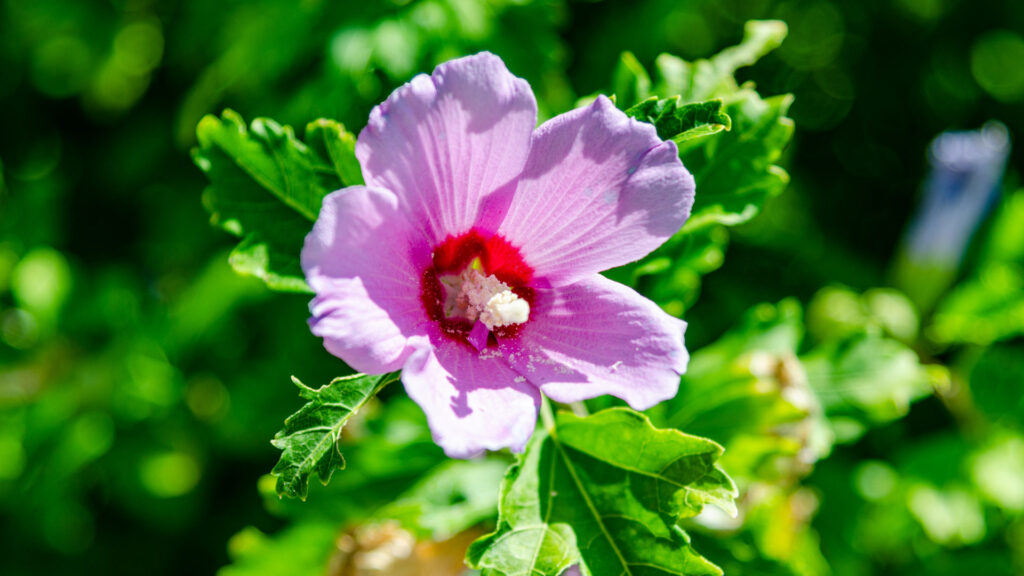
Ibisco Cinese
Appartiene alla famiglia delle Malvacee con circa 300 specie, originario dell’estremo oriente è chiamato anche “MUGUNGHAWA” o “ROSA DI SHARON”.
E’ un arbusto molto ramificato ha foglie ovali di colore verde scuro e fiori setosi larghi 7/8 cm che vanno dal bianco/viola/lilla. Predilige il clima temperato ma resiste anche basse temperature, si riproduce per talea o per semina.
Riesce a fiorire senza difficolta’ anche dopo il taglio, sopravvive anche se danneggiato, tanto che la simbologia orientale lo identifica come “fiore eterno” (MUGUNGHAWA) ,e dopo la liberazione della Corea dal potere giapponese, nel 1945, è diventato il fiore nazionale della repubblica di Corea ed è stato incluso nel suo inno nazionale.
E’ una pianta ornamentale amata dai giardinieri per la sua variopinta fioritura; i fiori grandi ed eleganti attirano api e farfalle, sbocciano ed appassiscono in pochi giorni ma vengono subito sostituiti da fiori nuovi. In genere non sono profumati, fatta eccezione per alcune specie (IBISCUS ARNOTTIANUS e IBISCUS WAIMAE).
Secondo alcuni studi la pianta possiede proprieta’ antibatteriche , cardioprotettive e diuretiche.
“Narra una leggenda cinese, di una bella ragazza innamorata del suo sposo non vedente. Durante una passeggiata a cavallo un nobile la vide, si invaghì di lei e tentò di convincerla a lasciare suo marito, ma dopo i suoi rifiuti, rapì la ragazza per portarla a vivere al suo palazzo. Fece il possibile per convincerla ad amarlo, ma non riuscì in nessun modo, finchè accecato dalla gelosia uccise la giovane donna. Gli abitanti del villaggio la seppellirono vicino alla casa del marito, il quale distrutto dal dolore non volle più allontanarsi dalla tomba della sua amata. Dalla terra iniziò a spuntare un germoglio, che divenne una stupenda pianta di Ibisco dai grandi fiori, realizzando un miracolo con la forza del loro Amore”.
Chinese Hibiscus
It belongs to the Malvaceae family with about 300 species, native to the Far East and is also called “MUGUNGHAWA” or “ROSE OF SHARON”. It is a very branched shrub with dark green oval leaves and silky flowers 7/8 cm wide ranging from white / purple / lilac. It prefers the temperate climate but also resists low temperatures, it reproduces by cutting or by sowing.
It manages to bloom without difficulty even after cutting, it survives even if damaged, so much so that the oriental symbology identifies it as an “eternal flower” (MUGUNGHAWA), and after the liberation of Korea from Japanese power, in 1945, it became the flower of the Republic of Korea and was included in its national anthem.
It is an ornamental plant loved by gardeners for its colorful flowering; the large and elegant flowers attract bees and butterflies, they bloom and wither in a few days but are immediately replaced by new flowers. Generally they are not scented, except for some species (IBISCUS ARNOTTIANUS and IBISCUS WAIMAE).
According to some studies, the plant has antibacterial, cardioprotective and diuretic properties.
“A Chinese legend tells of a beautiful girl in love with her blind husband. During a horse ride a nobleman saw her, fell in love with her and tried to convince her to leave her husband, but after her refusal, he kidnapped the girl to take her to live in his palace. He did everything possible to convince her to love him, but he could not in any way, until blinded by jealousy he killed the young woman. The villagers buried her near the house of her husband, who destroyed from the pain he no longer wanted to leave the grave of his beloved. A sprout began to sprout from the earth, which became a stupendous Hibiscus plant with large flowers, creating a miracle with the strength of their Love”.
Hibiscus Chinois
Elle appartient à la famille des Malvacées avec environ 300 espèces, originaire d’Extrême-Orient et est aussi appelée « MUGUNGHAWA » ou « ROSE DE SHARON ».
C’est un arbuste très ramifié aux feuilles ovales vert foncé et aux fleurs soyeuses de 7/8 cm de large allant du blanc/violet/lilas. Cette plante préfère un climat tempéré mais résiste aussi aux basses températures, elle se reproduit par bouturage ou par semis.
Elle parvient à fleurir sans difficulté même après avoir été coupée, elle survit même si elle est endommagée, à tel point que la symbologie orientale l’identifie comme une “fleur éternelle” (MUGUNGHAWA), et après la libération de la Corée du pouvoir japonais, en 1945, elle est devenue la fleur de la République de Corée et a été inclus dans son hymne national.
Il s’agit d’une plante ornementale appréciée des jardiniers pour sa floraison colorée; les fleurs grandes et élégantes attirent les abeilles et les papillons, elles fleurissent et fanent en quelques jours mais sont immédiatement remplacées par de nouvelles fleurs. Généralement ils ne sont pas parfumés, sauf pour certaines espèces (IBISCUS ARNOTTIANUS et IBISCUS WAIMAE).
Selon certaines études, la plante en question aurait des propriétés antibactériennes, cardioprotectrices et diurétiques.
“Une légende chinoise raconte l’histoire d’une belle fille amoureuse de son mari aveugle. Au cours d’une balade à cheval, un noble la vit, tomba amoureux d’elle et tenta de la convaincre de quitter son mari, mais après son refus, il kidnappa la jeune fille pour l’emmener vivre dans son palais. Il fit tout son possible pour la convaincre de l’aimer, mais il échoua en aucune façon, jusqu’à ce qu’aveuglé par la jalousie, il tua la jeune femme. Les villageois l’enterrèrent près de la maison de son mari, qui la détruisit par douleur, il ne voulait plus quitter la tombe de sa bien-aimée. Une pousse a commencé à germer de la terre, qui est devenue une magnifique plante d’hibiscus à grandes fleurs, créant un miracle avec la force de leur amour”.

